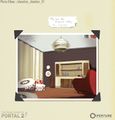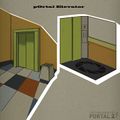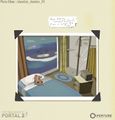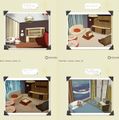Directed Design Experiments
| This article is non-canon. | ||
|---|---|---|
The subject matter of this article does not take place in the "real" Half-Life and Portal universe and is considered non-canon. |
| This article would greatly benefit from the addition of one or more new images. | ||
|---|---|---|
Please upload one or several relevant images (from canonical / official sources) and place it here. Once finished, this notice may be removed. |
The Directed Design Experiments[1] was a concept coined by Gabe Newell and Tom Leonard in November 2007, and led by the latter.[2] It consisted of shutting down Valve's production pipeline for a few months and turning the company into one big creative playground. Some of the experiments, described in detail in The Final Hours of Portal 2, led to what eventually became Portal 2.
Contents
Overview[edit]
In November 2007, Gabe Newell got the idea of shutting down Valve's production pipeline for a few months and turning the company into one big creative playground. He proposed the idea of "Directed Design Experiments" to his employees, hoping it would lead to a creative renaissance. The Valve employees started brainstorming in small teams for about 3 to 4 months, with no news from Valve to the public during that period.
At the end of the brainstorming in February 2008, the Valve employees gathered at a local movie theater in Bellevue, Washington for an internal "science fair" of their new design experiments, where was to be showcased "more innovation in 60 minutes than most game companies will see in a lifetime." Most of the experiments showed to be inspiring, some were funny, few did not work at all.
First experiment: Blobulator[edit]
The first team, "Team Shirley Temple", led by Ken Birdwell, focused on the idea of introducing liquid simulation into the Source engine, through the Blobulator demo. The demo consisted of blobs of a mercury-like substance that could procedurally attack the player, run over and drown enemies, and re-assemble like the T-1000 in the film Terminator 2: Judgment Day. The "npc_surface" featured in the Source Particle Benchmark stems from it; some of its properties were eventually reused for the Mobility Gels appearing in Portal 2.
Second experiment: Modular A.I.[edit]
The second team, made of John Guthrie, Tom Leonard and Steve Bond, demonstrated their idea of modular artificial intelligence. Their experiment consisted of Combine Soldiers having different chips on their uniforms that would activate abilities such as flying and super-speed. A player would shoot an enemy, who would be blown to pieces, but with a twist: Another enemy would then run over, find stray ability chips other soldiers would have dropped, and would upgrade their abilities on the spot.
Third experiment: Two Bots, One Wrench[edit]
The third team, "The Elders of Zion", named as such because the group was largely comprised of Jewish employees, included Erik Wolpaw, Ido Magal, Matt Wood, and Elan Ruskin. They showcased the Two Bots, One Wrench experiment, the name being a play on the infamous 2007 scatological video 2 Girls 1 Cup. The experiment involved the player as a wrench-wielding hero and two AI-driven robots, one brown with a deep, masculine voice, rough and gruff (voiced by Richard Lord, who also provided the placeholder voice for Wheatley), the other with a proclivity for wearing hats and a high-pitched, feminine voice. Their colors are seen to vary from one video to another. It was set in modified maps of Nova Prospekt, among others.
The primary goal of the experiment was to push in-game storytelling into a new direction: the two AI-driven characters would behave according to the player's action and events around them in real time, not as pre-determined scripts, and play with each other, resulting in sequences that proved to be hilarious and inspiring.
In SteamVR Home, the heads of both robots were re-purposed as optional models for the player's avatar.
Gallery[edit]
The robots examining Dr. Breen's Private Reserve.
The gruff robot mistaking the Garden Gnome for a leprechaun.
Fourth experiment: Time[edit]
The fourth team, lead by Kim Swift, was inspired to run a more practical experiment and see where the very successful portal technology might go in the future, and added the use of time to solve portal-based puzzles, the player recording themself creating a portal, then reusing it afterward with a second portal to solve the puzzle. While Swift and her team were thinking this concept would potentially become Portal 2, Newell realized, after being initially optimistic, that it was not going to work, as it was not fun and too complicated. Swift, who left Valve in 2009, still thinks the concept could work. A similar concept is featured in the Portal 2 mod Thinking with Time Machine.
Fifth experiment: F-STOP[edit]
This section is empty or incomplete. Maybe you can help by expanding it. |

This one experiment is said to have been worth stalling everything else at Valve for the three months of brainstorming. Named F-STOP after the camera photography term, this never-before-disclosed project was headed by a team including producer Joshua Weier. Using the cartoon visual style of Team Fortress 2, Weier and his team mocked up a completely new, nonviolent, puzzle-based mechanic for a game which consisted of taking pictures of objects, changing their size, and using them to solve puzzles in the environment.[source?] The other employees considered it fun, memorable, and most importantly fresh and completely unexpected.
A few days after the science fair, Newell summoned Weier and the team to his office to ask them if they would be willing to look into making F-STOP a prequel to Portal, as he thought it could be the big, unexpected idea that Valve needed for a sequel. Weier was a little shocked: Portal was such a sensation, such an outright phenomenon, no one wanted to be responsible for trying to one-up it.
But as the team worked on F-STOP, it did not become Portal 2, and it would take Valve nearly a year of intense development before they figured that out.[3]
Gallery[edit]
At least one image in this gallery is not captioned. You can help by describing the files below. |
References[edit]
External links[edit]
 Two Bots, One Wrench Video #1 on YouTube
Two Bots, One Wrench Video #1 on YouTube Two Bots, One Wrench Video #2 on YouTube
Two Bots, One Wrench Video #2 on YouTube Two Bots, One Wrench Video #3 on YouTube
Two Bots, One Wrench Video #3 on YouTube Exposure by LunchHouse Software on YouTube - a fanmade recreation of F-STOP's game mechanics using Valve's original official code
Exposure by LunchHouse Software on YouTube - a fanmade recreation of F-STOP's game mechanics using Valve's original official code















